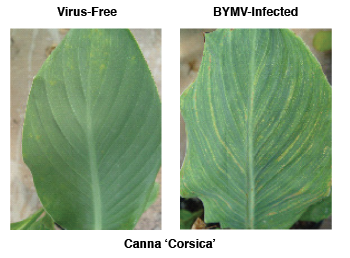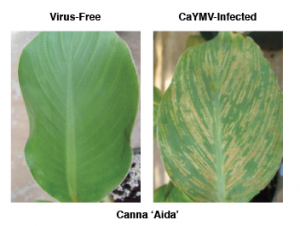Plant Viruses Infecting Cannas
Introduction
Cannas are popular landscape plants with vibrant broad-leaf foliage and colorful flowers that enhance any garden or patio. Cannas stand out among flowering plants because they are bred for their distinctive foliage and vibrant showy flowers. Dwarf varieties range from two to three feet tall and standard varieties can reach five or six feet tall. The lush green foliage of ‘Miss Oklahoma’ or ‘Orange Beauty,’ deep burgundy of ‘Australia’ or ‘Burning Ember,’ or the variegated ‘Pretoria’ are a few examples of the color and beauty cannas possess. Cannas produce flowers that last all summer through autumn frost with colors that vary from delicate pinks to vivid shades of yellow, red, and orange. Cannas are hardy, enjoy full sun, and are easy to grow in gardens or in containers. They require very little maintenance if grown in moist, rich soil or in medium loamy soils with mulch. These qualities have made cannas a popular choice for landscapers and homeowners around the world.
Most cannas sold by nurseries and garden centers are hybrid cultivars that are crosses between two or more species. Hybrids require “vegetative propagation” to produce plants that are homogenously representative of the mother plant. Vegetative propagation does not depend on flower production, but rather cultivation and division of the rhizome. Canna rhizomes are large and have many eyes which can often be divided into thirds. Homeowners will sometimes dig up rhizomes at the end of a growing season to divide and replant in other areas of the garden. Rhizomes are cut with a knife, separating the buds to produce new progeny. This method of division can spread viral diseases, resulting in decline in clonal vigor. Homeowners sometimes store bulbs overwinter and replant them the following season. If rhizomes are infected before planting, they carry the virus inoculum that could spread throughout the garden and into the following season. Thus, viruses can spread from year to year and persist through seasonal planting stocks.
Plant Virus Symptoms
In the last two decades, researchers have identified five common viruses that infect cannas: Canna yellow streak virus (CaYSV), Canna yellow mottle virus (CaYMV), Bean yellow mosaic virus (BYMV), Cucumber mosaic virus (CMV), and Tomato aspermy virus (TAV). Leaves of virus-infected plants show a range of symptoms including yellow mosaic, striations, severe discoloration, and necrosis along the veins. An example of CaYMV-infected ‘Aida’ shows severe necrosis in areas between the veins and throughout the leaf (Figure 1). An example of BYMV-infected ‘Corsica’ shows the yellow mosaic disease pattern throughout the leaf (Figure 1).
Many canna varieties have red/green foliage and disease symptoms look different from
the green leaf varieties (Figure 2). In healthy leaves, the red coloration stretches
along the veins and the edges of the leaf. In contrast, BYMV-infected leaves show
severe yellow mosaic symptoms, and red coloration is quite narrow along veins and
mostly depleted from the margins.


Figure 1. Contrasts healthy and virus infected green leaves of two varieties: ‘Aida’ and ‘Corsica’.

Figure 2. Healthy and virus infected.
Virus Management in the Home Garden
The most common way to deal with virus outbreaks is to destroy any plants showing symptoms and separate new plants from established flower beds. Commercial producers of cannas practice a technique called “roguing” to select plants of superior quality. Roguing requires the producer to search through rows of cannas that are in full bloom and discard those that appear to vary visually from the desired characteristics. Plants can be four to six feet tall in the field and it can take four months to reach full bloom, which means a significant amount of manpower and resources are spent growing plants before they are rouged. Additionally, the production fields are sprayed to remove pests. These recommended methods will ensure that the plants purchased by the consumer are clean and vibrant additions to their home garden. However, many canna producers worldwide have difficulty screening their plants for virus-related symptoms and many people continue to receive infected plants among their purchases.
For the home gardener, viruses such as BYMV, CMV, and TAV can occur in vegetable gardens. These viruses are transmitted by aphids which could move to and infect canna plants. It is recommend growing cannas as far away from the home vegetable garden as possible to keep them virus free. Also, insecticide treatments should repel or kill target pests of both vegetable plants and cannas to reduce the likelihood of virus transmission to cannas. Many homeowner products are available at local garden centers. For current recommendations on chemical control of insect pests of home gardens, see Oklahoma Cooperative Extension Service Fact Sheet EPP-7306: Ornamental and Lawn Pest Control (For Homeowners).
References
Fisher, J, Sanchez-Cuevas, M-C, Nameth, S and Woods, V (1997) First report of cucumber mosaic virus in Eryngium amethystinum, Canna spp., and Aquilegia hybrids in Ohio. Plant Dis., 81, 1331.
Hayward, K (2008) Thoughts on virus from Hart Canna: Canna virus disease. In http://cannanews.blogspot.com/2008/01/thoughts-on-virus-from-hart-canna.html: Canna News.
Lockhart, B (1988) Occurrence of canna yellow mottle virus in North America. Acta Horticulturae, 234, 69-72.
Monger, WA, Harju, V, Skelton, A, Seal, SE and Mumford, RA (2007) Canna yellow streak virus: a new potyvirus associated with severe streaking symptoms in canna. Arch Virol, 152, 1527-1530.
Pappu, H and Druffel, K (2008) Canna yellow mottle virus in Canna spp. in Washington State. Plant Dis., 92, 1136.
Jeanmarie Verchot
Professor of Plant Virology
Punsasi Rajakaruna
Senior Research Specialist
